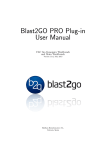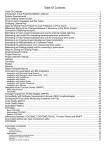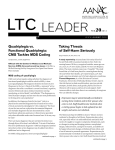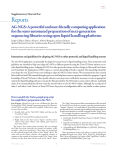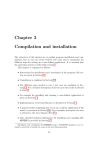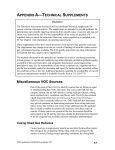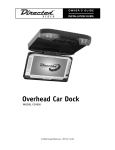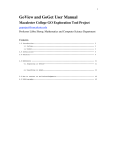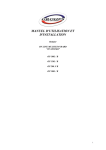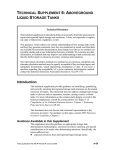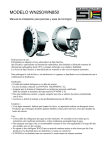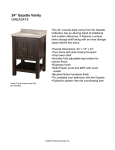Download Blast2GO Plugin User Manual
Transcript
Blast2GO Plugin User Manual For CLC bio Genomics Workbench and Main Workbench Version 1, Feb. 2013 BioBam Bioinformatics S.L. Valencia, Spain Contents Introduction 1 Quick-Start 2 Blast2GO Plugin Manual 1 Blast2GO Plugin . . . . . . . . . . . . . . . . 1.1 Blast2GO Plugin Toolbox functions . 1.2 The Blast2GO sequence Table . . . . 1.3 Blast2GO Sequence Table Side Panel . 2 BLAST . . . . . . . . . . . . . . . . . . . . . 3 Mapping . . . . . . . . . . . . . . . . . . . . . 4 Annotation . . . . . . . . . . . . . . . . . . . 5 InterProScan . . . . . . . . . . . . . . . . . . 6 GO-Slim . . . . . . . . . . . . . . . . . . . . . 7 Manage Projects . . . . . . . . . . . . . . . . 8 Miscellaneous . . . . . . . . . . . . . . . . . . 9 Analysis . . . . . . . . . . . . . . . . . . . . . 9.1 Create Combined Graphs . . . . . . . 9.2 Create Pie Chart . . . . . . . . . . . . 9.3 Statistics . . . . . . . . . . . . . . . . . . . . . . . . . . . . . . . . . . . . . . . . . . . . . . . . . . . . . . . . . . . . . . . . . . . . . . . . . . . . . . . . . . . . . . . . . . . . . . . . . . . . . . . . . . . . . . . . . . . . . . . . . . . . . . . . . . . . . . . . . . . . . . . . . . . . . . . . . . . . . . . . . . . . . . . . . . . . . . . . . . . . . . . . . . . . . . . . . . . . . . . . . . . . . . . . . . . . . . . . . . . . . . . . . . . . . . . . . . . . . . . . . . . . . . . . . . . . . . . . . . . . . . . . . . . . . . . . . . . . . . . . . . . . . . . . . . . . . . . . . . . . . . . . . . . . . . . . . . . . 4 4 4 4 4 5 5 5 7 7 8 8 9 9 10 10 A Blast2GO Workflow 15 Please Cite 18 Copyright 2013 - BioBam Bioinformatics S.L. Introduction Support: [email protected] Website: http://www.blast2go.com Blast2GO [Conesa et al., 2005] is a methodology for the functional annotation and analysis of gene or protein sequences. The method uses local sequence alignments (BLAST) to find similar sequences (potential homologs) for one or several input sequences. The program extracts all GO terms associated to each of the obtained hits and returns an evaluated GO annotation for the query sequence(s). Enzyme codes are obtained by mapping from equivalent GOs while InterPro motifs can directly be queried at the InterProScan web service. A basic annotation process with Blast2GO consists of 3 steps: blasting, mapping and annotation. These steps will be described in this manual including further explanations and information on additional functions. [Götz et al., 2008] Copyright 2013 - BioBam Bioinformatics S.L. 1 Quick-Start This section gives a quick survey on a typical Blast2GO usage. Detailed descriptions of the different steps and possibilities of this plugin are given in the remaining sections of this manual. 1. Load data: To start an annotation proccess load a Fasta sequence file: Menu →Import →Standard Import →File Type: Blast2GO Blast Result / Fasta File You can also add an example dataset to your Navigation Area from: Edit →Preferences →Gerneral →Blast2GO →Create Blast2GO Example Dataset This dataset contains 10 sequences as plain sequences. 2. Blast your sequences: Please see: BLAST at NCBI in the workbench Help Note: If we already have a set of blasted sequences we can use the Import function from the main menu to create a new Blast2GO project. I we want to add Blast results in XML format to an already existing project we will have to use the function File →Import Blast Result XML from the main menu. 3. Convert Blast to Blast2GO Project: Go to Toolbox →Manage Project →Convert Data to Blast2GO Project to convert your Blast results into a Blast2GO Project. 4. Perform Gene Ontoloy Mapping: Go to Toolbox →Mapping →Mapping to start the mapping. Mapped sequences will turn green. Once Mapping is completed visualize your results at Mapping →Mapping Statistics. 5. Annotation: Go to Toolbox →Annotation →Annotation to run the annotation step. Leave the default parameters for the annotation rule as well as the Evicence Codes. Annotated sequences will turn blue. 6. Generate Statistic Charts: Once the annotation process is finished we can generate all the different statistics charts from: Toolbox →Miscellaneous →Statistics 7. Modify Annotations: To modify the annotations click on one of the sequences form the Blast2GO sequence table with the left mouse button and select Change Annotation and Description. To change the extent of annotations we can add implicit terms via Annex (Toolbox →Miscellaneous →Run Annex ) To reduce the amount of functional information and to summarize the functional content of a dataset run a GO-Slim reduction(Toolbox →GO-Slim →GO-Slim). 8. InterProScan: To complement the Blast-based annotations with domain-based annotations run an InterProScan Search. Go to Toolbox →InterProScan. This step is recommended to improve the annotation outcome. Once InterProScan results are retrieved use Merge InterProScan to add the GO terms obtained through motifs/domains to the current/existing annotations. Note: If we already have a set of InterProScan results in XML format we can add them to the existing Blast2GO project from the main menu: File →Import InterProScan XMLs. Copyright 2013 - BioBam Bioinformatics S.L. 2 9. Export Results: Once the annotation process has concluded several options exist to export the results via the Workbench Export function. • annot-file: The annot file is the standard format to export GO annotations. It is a tab-separated text file, each row contains one GO term. • dat-file: The standard Blast2GO project file. This file can also be opened with the standalone Blast2GO application. • Sequence Table: A tab-separated text file containing all the information given in the Blast2GO sequence table. • GAF 2.0: A tab-separated text file of the funtional information in the Gene Ontology annotation file format. The content of this format can also be viewed within the Workbench via the Create Annotation Table function from the toolbox. Copyright 2013 - BioBam Bioinformatics S.L. 3 Blast2GO Plugin Manual 1 Blast2GO Plugin 1.1 Blast2GO Plugin Toolbox functions • BLAST: Contains functions for performing BLAST searches and resetting results. • Gene Ontology Mapping of Blast results: This function fetches GO terms associated to hit sequences obtained by BLAST. • Functional Annotation: Includes different functions to obtain and modulate GO, computing GoSlim view, Enzyme Code annotation with KEGG maps and InterPro annotation. • InterProScan Domain Searches • GO-Slim Reduction • Analysis: This tab hosts different options for the analysis of the available functional annotation. Includes graphical exploration through the Combined Graph Display and performing statistical analysis of GO distributions for groups of sequences • Combined Graphs: This tab offers different descriptive statistics charts for the results of BLAST, mapping and annotation. • Pie Charts: This tab offers different descriptive statistics charts for the results of BLAST, mapping and annotation. • Statistics Charts: This tab offers different descriptive statistics charts for the results of BLAST, mapping and annotation. • Various data import and export formats 1.2 The Blast2GO sequence Table • Colors: Different colors indicate the status of each sequence. • Context menu: Several options available for a single sequences are available via the rightclick context menu. Figure 3.1: Different colour codes indicating the status of the sequences 1.3 Blast2GO Sequence Table Side Panel • Select: Allows to make sequence selections based on the sequences status (colors), sequence names, functions (GO terms or IDs) or sequence descriptions. • View: Switch the main table view from GO-IDs to term, show only selected sequences, show/hide GOs of InterProScan results and color highlight the different GO categories. Copyright 2013 - BioBam Bioinformatics S.L. 4 • Filter: Filter or hide sequences. • Delete: Delete all selected sequences. 2 BLAST Import Blast Import Blast via the general Workbench import function. Please go to: Menu →Import →Standard Import and select the file type Blast2GO Project via Blast XML result (.xml) For further instructions please see: Import using the import dialog in the CLC bio Workbench Help. 3 Mapping Mapping is the process of retrieving GO terms associated to the hits obtained after a BLAST search. To run mapping, select one or various data-sets, which contain blasted sequences and execute the mapping function. When a BLAST result is successfully mapped to one or several GO terms, these will come up at the GOs column of the Main Sequence Table. Assigned GOs to hits can be reviewed in the BLAST Results Browser. Successfully mapped sequences will turn green. R performs different mapping steps to link all BLAST hits to the functional information Blast2GO R uses different public resources provided stored in the Gene Ontology database. Therefore Blast2GO by the NCBI, PIR and GO to link the different protein IDs (names, symbols, GIs, UniProts, etc.) to the information stored in the Gene Ontology database - the GO database contains several million functionally annotated gene products for hundreds of different species. All annotations are associated to and Evidence Code which provides information about the quality of this functional assignment. 1. BLAST result accessions are used to retrieve gene names or Symbols making use of two mapping files provided by NCBI. Identified gene names are than searched in the species specific entries of the GO database. 2. BLAST result GI identifiers are used to retrieve UniProt IDs making use of a mapping file from PIR including PSD, UniProt, Swiss-Prot, TrEMBL, RefSeq, GenPept and PDB. 3. BLAST result accessions are searched directly in the GO database. Statistics Three evaluation charts are available to summarize the mapping results. The ”DB resources of mapping” chart shows from which database annotations has been obtained and the Evidence Code distribution for hits and sequences indicated how EC associate in the obtained GO pool. Note that in most cases IEA (electronic annotation) are overwhelmed in the mapping results. However, the contribution of this (and other) type of annotation to the finally assigned annotations to the query set can be modulated at the annotation step. Reset Mapping Removes already obtained results for a given dataset. 4 Annotation This is the process of selecting GO terms from the GO pool obtained by the Mapping step and assigning them to the query sequences. GO annotation is carried out by applying an annotation rule (AR) on the found ontology terms. The rule seeks to find the most specific annotations with a certain level of reliability. This process is adjustable in specificity and stringency. For each candidate GO an annotation score (AS) is computed. The AS is composed of two additive terms. The first, direct term (DT), represents the highest hit similarity of this GO weighted by a factor corresponding to its EC. The second term (AT) of the AS provides the possibility of abstraction. This is defined as annotation to a parent node when several child nodes are present in the GO candidate collection. This term multiplies the number of total GOs unified at the node by a user defined GO weight factor that controls the Copyright 2013 - BioBam Bioinformatics S.L. 5 (a) Toolbox area (b) Sequence editor side-panel Figure 3.2: User Interface: The Blast2GO Toolbox and the Main Sequence Side-Panel Copyright 2013 - BioBam Bioinformatics S.L. 6 possibility and strength of abstraction. When GO weight is set to 0, no abstraction is done. Finally, the AR selects the lowest term per branch that lies over a user defined threshold. DT, AT and the AR terms are defined as given in Figure 1. To better understand how the annotation score works, the following reasoning can be done: When EC-weight is set to 1 for all ECs (no EC influence) and GO-weight equals zero (no abstraction), then the annotation score equals the maximum similarity value of the hits that have that GO term and the sequence will be annotated with that GO term if that score is above the given threshold provided. The situation when EC-weights are lower than 1 means that higher similarities are required to reach the threshold. If the GO-weight is different to 0 this means that the possibility is enabled that a parent node will reach the threshold while its various children nodes would not. The annotation rule provides a general framework for annotation. The actual way annotation occurs depends on how the different parameters at the AS are set. 1. E-Value Hit Filter. This value can be understood as a pre-filter: only GO terms obtained from hits with a greater e-value than given will be used for annotation and/or shown in a generated graph (default=1.0E-6). 2. Annotation Cut-Off (threshold).The annotation rule selects the lowest term per branch that lies over this threshold (default=55). 3. GO-Weight. This is the weight given to the contribution of mapped children terms to the annotation of a parent term (default=5). 4. Hsp-Hit Coverage CutOff. Sets the minimum needed coverage between a Hit and his HSP. For example a value of 80 would mean that the aligned HSP must cover at least 80% of the longitude of its Hit. Only annotations from Hit fulfilling this criterion will be considered for annotation transference. 5. EC-Weight. Note that in case influence by evidence codes is not wanted, you can set them all at 1. Alternatively, when you want to exclude GO annotations of a certain EC (for example IEAs), you can set this EC weight at 0. Successful annotation for each query sequence will result in a color change for that sequence from lightgreen to blue at the Main Sequence Table, and only the annotated GOs will remain in the GO IDs column. An overview of the extent and intensity of the annotation can be obtained from the Annotation Distribution Chart, which shows the number of sequences annotated at different amounts of GO-terms. Reset Annotation Removes already obtained results for a given dataset. 5 InterProScan R allows to retrieve domain/motif information The functionality of InterPro annotations in Blast2GO in a sequence-wise manner. The processed sequence have to contain a valid sequence string, which is not the case when they were just imported through a blast-result-file. IPRscan results can be viewed through the Single Sequence Menu. Merge InterProScan In this step the obtained GO terms have to be transferred to the sequences and merged with already existent GO terms. Reset InterProScan Removes already obtained results for a given dataset. 6 GO-Slim GO-Slim is a reduced version of the Gene Ontology that contains a selected number of relevant GO terms. The GO-Slim algorithm generates a GO-Slim mapping for the available annotations and permits in this way the projection of certain specific terms into more generic ones i.e. GO-Slim summarizes a set of GO annotations from e.g. a whole-genome microarray analysis to a simpler, more general functional R supports schema. Different GO-Slims are available which are adapted to specific organisms. Blast2GO Copyright 2013 - BioBam Bioinformatics S.L. 7 the following GO-Slim mappings: General, Plant, PIR, Yeast, GOA (GO-Association), TAIR, Candida and Pombe. GO-Slim is often used before a GO Combined Graph is generated. GoSlim performs a graph pruning based on a manually defined subset of more general GO terms in order to summarize the information in a graph. The result is that a DAG of thousands of nodes can be “summarized” or slimmed to a few dozen key terms, which makes the graph navigable and easy to interpret. However, the GoSlim method has several characteristics that are not always appropriate. The manually defined subsets are context dependent (e.g different definitions for different species), the level/degree of abstraction is static, and information at more specific levels is blurred. 7 Manage Projects Combine Datasets R project with another .dat or .annot This function allows to combine an already existing Blast2GO file. In the case of .dat files, only those sequences will be added to the existing data-set which sequence names do not already exist . In case of the .annot file, annotation information will be added and merged i.e. if a sequence with a given sequence name already exists in the data-set, the new annotations will be added to this sequences and a validation check is performed (see section 8). Convert Data to Blast2GO Project R project. This function allows to convert various CLC bio data-types to a Blast2GO Supported CLC bio data-types are: • Nucleotide Sequence(s) • Protein Sequence(s) • BLAST-Result 8 Miscellaneous Blast Description Annotation R is to assign functional labels in form of GO-terms to nucleotide or The primary goal of Blast2GO protein sequences. However, not only functional labels but also a meaningful description for novel sequences is desired. A common approach is to directly transfer the ”Best-BLAST-hit description to the novel sequence. It is frequent that best-hit descriptions are of low-informative text such as ”unknown”, ”putative” or ”hypothetical” while descriptions of other Blast hits of the same sequence do contain R . informative keywords. For this reason, a text-mining functionality has been included in Blast2GO It analyses a set of sequence descriptions of a given BLAST result. The feature is called the BLAST Description Annotator (BDA). Depending on the frequency of occurrence and the information content, the most suitable description is selected out of the collection of words. In this way, this simple approach avoids sequence descriptions like for example ”hypothetical”, ”putative” or ”unknown protein” in the case that a more informative and representative description is available. These descriptions are only of exploratory nature and do not have the same weight of evidence as the functional labels. Validate Annotation This function validates the annotation result and removes redundant GOs from the dataset. It assures that only the most specific annotations for a given sequence are saved. In this way this function prevents that two or more GO terms lying on the same GO branch are assigned to the same sequence. The Gene Ontology ”true path rule” assures that all the terms lying on the branch or route from a term up to the root (top-level) must always be true for a given gene product. Therefore, any term is considered as redundant and is removed if a child term coexists for the same sequence. R applies this method automatically always This function can be run independently, however Blast2GO after a modification is made to an existing annotation, such as merging GO terms from InterProScan search, after Annex augmentation or upon manual curation. Remove 1. Level Annotations This function removes for each sequence the three main (root or top-level) GO terms (molecular function, biological process and cellular component), if present since they do not provide any relevant information. Copyright 2013 - BioBam Bioinformatics S.L. 8 Create Annotation Table This function allows to create an CLC-bio Annotation Table containing the Gene Ontology terms genR . erated with Blast2GO ANNEX Annex (Myhre et al., 2006), developed by the Norwegian University of Science and Technology, is essentially a set of relationships between the three GO categories. Basically, this approach uses univocal relationships between GO terms from the different GO Categories to add implicit annotation. Annex consists of over 6000 manually reviewed relations between molecular function terms ”involved in” biological processes and molecular function terms ”acting in” cellular components. Annex-based GO term augmentation can be run on any annotation loaded in Bast2GO. Generally, between 10% and 15% extra annotation is achieved and around 30% of GO term confirmations are obtained through the Annex data-set. For more details visit the Annex Project at: The Annex dataset connects molecular functions with terms from the biological process and cellular component GO categories. Create Blast2GO Example Dataset This functions allows to add several small example data-set to the Navigation Area in the Workbench. Each file contains just 10 sequences which allows to easily explore the different possibilities of the plugin. 9 Analysis 9.1 Create Combined Graphs Visualization is a helpful component in the process of interpreting results from high-throughput experiments, and can be indispensable when working with large data-sets. Within the GO, the “natural” visualization format is the Direct Acyclic Graph of a group of annotated sequences. In the DAG, each node represents a GO term. Arcs represent the relationships between the biological concepts. A problem when visualising GO functional information of genomic data-sets is that these graphs can become extremely large and difficult to navigate when the number of represented sequences is high. Combined Graphs R is the ability to display the annotation result of one or several One of the functions of Blast2GO R these graphs are called “Combined Graphs”. sequences in the same GO graph. Within Blast2GO The function generates joined GO DAGs to create overviews of the functional context of groups of annotations and sequences. Combined Graph nodes are highlighted through a colour scale proportional to their number of sequences annotated to a given term. This confluence score (from now on denoted “node-Score”) takes into account the number of sequences converging at one GO term and at the same time penalizes by the distance to the term where each sequence was actually annotated. Assigned sequences and scores can be displayed at the terms level. Node Score The node score is calculated for each GO term in the DAG and takes into account the topology of the ontology and the number of sequences belonging (i.e. annotated) to a given node (i.e. GO term). The score is the sum of sequences directly or indirectly associated to a given GO term weighted by the distance of the term to the term of “direct annotation” i.e. the GO term the sequence is originally annotated to. This weighting is achieved by multiplying the sequence number by a factor α [0,∞] to the power of the distance between the term and the term of direct annotation (see Equation 3.1 for a mathematical expression. In this way, the node score is accumulative and the information of lower-level GO-terms is considered, but the influence of more distant information (i.e. annotations) is suppressed/decreased depending on the value of α. This compensates for the drawback of the earlier described method of simply counting the number of different sequences assigned to each GO-term. The α parameter allows this behaviour to be further adjusted. A value of zero means no propagation of information and can be increased by rising α. X score(g) = gp(ga ) · αdist(g,ga ) (3.1) ga ∈desc(g) where: • desc(g) represents all the descendant terms for a given GO term g Copyright 2013 - BioBam Bioinformatics S.L. 9 • dist(g,ga ) is the number of edges between the GO term g and the GO term ga • g is an element of the GO where GO is the overall set of all GO terms • gp(g) is the number of gene products assigned to a given GO term g Graph Term Filtering Combined graphs can become extremely large and difficult to navigate when the number of visualized sequences is high. Additionally, the relevant information in these cases is frequently concentrated in a relatively small subset of terms. We have introduced graph-pruning functions to simplify DAG structures to display only the most relevant information. In the case of the Combined Graph function, a cutoff on the number of sequences or the node-score value can be set to filter out GO terms. In this case the size of a graph is reduced without loosing the important information (i.e hiding tip and intermediate low informative nodes). This approach of graph-filtering and trimming is based on a combination of different scoring schemes. On the one hand, graph filtering can be based on the number of sequences assigned to each node, and on the other hand, a graph can be “thinned out” by removing intermediate nodes that are below a given cutoff. The latter approach allows a certain level of details to be maintained while drastically reducing the size of the graph by removing “unimportant” intermediate graph elements. In this way, any large GO graph can be reduced by abundance and information content instead of simply “cutting through” the Gene Ontology at a certain hierarchical level or by the use of GoSlim definitions. In Figure 3.3, the molecular functions of 1000 sequences are visualized in 3 different ways. The first graph is unfiltered, the second graph shows the functional information after having applied a GoSlim reduction. The third graph is filtered and thinned according to the number of sequences belonging to each GO-term and the node-score. All GO terms with less than 10 sequences were removed (tip nodes) and all the nodes with a node-score smaller than 12 applying an α of 0.4 were removed (intermediate nodes). This strategy allows the removal of terms that are less significant to a particular data-set while at the same time it maintains frequently present terms at lower levels of specificity. 9.2 Create Pie Chart R offers pie charts as summary representations of annotation results. Single GO level pie Blast2GO charts as well as multi-level pie function is provided. In the latter only the lowest GO terms per branch that fulfil a user-specified annotation weight criteria, i.e. sequence abundance or node-scores are shown. In this way, the GO DAG can be “cut” locally at different levels to provide an optimal view of the dataset’s most relevant terms. 9.3 Statistics The Statistics wizard allows to select and generate all available charts in one run. Satistical charts are available to provide direct feedback about data composition. Charts such as mean sequence length, involved species distribution, BLAST e-value distribution or the standard deviation of GO level annotation distribution, allow the visualisation of intermediate and final result summaries. These charts are especially helpful to validate the results of each analysis step and to re-adjust or determine the parameters of subsequent processing. In this interactive manner the annotation process can be adjusted to specific data-set and user requirements. List of all available quantitative/statistical charts in Blast2GO • BLAST • E-value distribution: This chart plots the distribution of E-values for all selected BLAST hits. It is useful to evaluate the success of the alignment for a given sequence database and help to adjust the Evalue cutoff in the annotation step. • Sequence similarity distribution: This chart displays the distribution of all calculated sequence similarities (percentages), shows the overall performance of the alignments and helps to adjust the annotation score in the annotation step. • Species distribution: This chart gives a listing of the different species to which most sequences were aligned during the BLAST step. Copyright 2013 - BioBam Bioinformatics S.L. 10 (a) Unfiltered Graph molecular_function NodeScore:576.59 is a nutrient reservoir activity NodeScore:4.00 is a is a molecular transducer activity NodeScore:5.40 translation regulator activity NodeScore:6.60 signal transducer activity NodeScore:9.00 is a transcription regulator activity NodeScore:21.00 is a antioxidant activity NodeScore:16.00 is a is a receptor activity NodeScore:5.00 is a translation factor activity, nucleic acid binding NodeScore:11.00 is a is a nucleic acid binding NodeScore:97.80 ion binding NodeScore:7.20 is a is a RNA binding NodeScore:37.00 is a is a lipid binding NodeScore:14.00 is a is a is a is a is a is a is a is a chromatin binding NodeScore:5.00 is a cytoskeletal protein binding NodeScore:1.80 is a passive transmembrane transporter activity NodeScore:1.30 is a calcium ion binding NodeScore:20.00 is a transmembrane transporter activity NodeScore:1.30 nucleotide binding NodeScore:131.00 is a receptor binding NodeScore:1.00 is a hydrolase activity NodeScore:121.88 is a is a hydrolase activity, acting on ester bonds NodeScore:4.08 is a is a substrate specific channel activity NodeScore:3.60 is a is a ion channel activity NodeScore:6.00 is a is a transferase activity, transferring phosphorus-containing groups NodeScore:22.32 peptidase activity NodeScore:27.00 is a hydrolase activity, acting on acid anhydrides, in phosphorus-containing anhydrides NodeScore:0.65 phosphotransferase activity, alcohol group as acceptor NodeScore:19.20 is a phosphatase activity NodeScore:3.00 is a is a is a is a is a transferase activity NodeScore:88.39 hydrolase activity, acting on acid anhydrides NodeScore:0.39 phosphoric ester hydrolase activity NodeScore:1.80 nuclease activity NodeScore:5.00 ion transmembrane transporter activity NodeScore:3.60 is a is a substrate-specific transporter activity NodeScore:1.30 substrate-specific transmembrane transporter activity NodeScore:2.16 channel activity NodeScore:2.16 structural molecule activity NodeScore:70.00 is a is a is a actin binding NodeScore:3.00 enzyme regulator activity NodeScore:26.00 catalytic activity NodeScore:323.16 is a protein binding NodeScore:111.68 is a metal ion binding NodeScore:12.00 is a electron carrier activity NodeScore:28.00 transporter activity NodeScore:64.78 is a is a cation binding NodeScore:12.00 transcription factor activity NodeScore:20.00 is a protein tag NodeScore:1.00 is a carbohydrate binding NodeScore:15.00 is a DNA binding NodeScore:65.00 is a binding NodeScore:411.01 is a pyrophosphatase activity NodeScore:1.08 is a kinase activity NodeScore:37.20 is a protein kinase activity NodeScore:32.00 is a phosphoprotein phosphatase activity NodeScore:5.00 nucleoside-triphosphatase activity NodeScore:1.80 is a motor activity NodeScore:3.00 GOSLIM GRAPH (b) Filtered Graph 1 molecular_function NodeScore:118.26 is a is a binding NodeScore:119.16 is a is a nucleic acid binding NodeScore:66.64 ion binding NodeScore:28.16 is a cation binding NodeScore:31.00 is a is a is a iron ion binding NodeScore:47.00 RNA binding NodeScore:33.76 is a transition metal ion binding NodeScore:48.80 is a nucleotide binding NodeScore:18.95 is a metal ion binding NodeScore:67.40 is ais a calcium ion binding NodeScore:20.00 copper ion binding NodeScore:14.00 is a magnesium ion binding NodeScore:21.00 is a is a is a 3 terms 1 term GTP binding NodeScore:22.00 1 term transcription regulator activity NodeScore:14.16 is a coenzyme binding NodeScore:13.60 protein binding NodeScore:88.67 1 term is a adenyl nucleotide binding NodeScore:16.40 DNA binding NodeScore:54.12 is a is a is a transferase activity NodeScore:21.19 is a unfolded protein binding NodeScore:16.00 1 term adenyl ribonucleotide binding NodeScore:32.00 phosphotransferase activity, alcohol group as acceptor NodeScore:17.63 is a transcription factor activity NodeScore:20.00 is a is a 1 term nucleoside-triphosphatase activity NodeScore:14.95 3 terms electron carrier activity NodeScore:27.40 endopeptidase inhibitor activity NodeScore:14.00 is a structural constituent of ribosome NodeScore:56.00 oxidoreductase activity NodeScore:53.68 3 terms is a transporter activity NodeScore:23.27 1 term peroxidase activity NodeScore:14.80 is a protein kinase activity NodeScore:41.47 is a protein tyrosine kinase activity NodeScore:13.00 ATP binding NodeScore:79.00 is a hydrolase activity NodeScore:25.08 1 term kinase activity NodeScore:24.40 is a is a zinc ion binding NodeScore:41.00 is a structural molecule activity NodeScore:34.40 catalytic activity NodeScore:71.59 1 term purine ribonucleotide binding NodeScore:16.32 1 term is a is a protein serine/threonine kinase activity NodeScore:20.28 is a heme binding NodeScore:22.00 FILTERED AND THINNED GRAPH (c) filtered Graph 2 Figure 3.3: The molecular functions of 1000 sequences visualized in 3 different ways: The first graph is unfiltered, the second graph shows the functional information after having applied a GoSlim reduction and the third graph is filtered and thinned according to the number of sequences belonging to each GO-term and the node-score. All GO terms with less than 10 sequences (tip nodes) and all intermediate terms with a node-score smaller than 12 (with α=0.4) were removed. Copyright 2013 - BioBam Bioinformatics S.L. 11 (a) (b) (c) (d) (e) (f) (g) (h) Figure 3.4: A collection of different Blast2GO Charts Copyright 2013 - BioBam Bioinformatics S.L. 12 (a) (b) (c) Figure 3.5: A collection of different Blast2GO Charts Copyright 2013 - BioBam Bioinformatics S.L. 13 • Top-Blast Species distribution: This chart gives the species distribution of the Top-BLAST HITs. • HSP/HIT coverage: This chart shows a distribution of percentages. The percentages represent the coverage between the HSPs and its corresponding HITs. This chart helps to get an understanding of the effect of this annotation parameter. • Mapping • Evidence Code distribution: This chart shows the distribution of GO evidence codes for the functional terms obtained during the mapping step. It gives an idea about how many annotations derive from automatic/ computational annotations or manually curated ones. • DB-source of mapping: This chart gives the distribution of the number of annotations (GO-terms) retrieved from the different source databases like e.g. UniProt, PDB, TAIR etc. • Annotation • Annotation progress/success: This chart shows the annotation status of the data-set i.e. how many sequences have or have not a BLAST result, how many sequences obtained a GO mapping and how many sequences could be annotated successfully or stayed without annotations. • Annotation distribution: This chart informs about the number of GO terms assigned per sequence. • GO term distribution: A chart for each GO category shows the most frequent GO terms within a dataset without taking into account the GO hierarchy. GO level distribution: This chart shows the distribution of GO levels for each GO category. This chart helps to analyse whether a set of annotations is more general (low GO levels) or more specific (higher GO levels). • Sequence length distribution: This chart shows the correlation between length of the sequences and the number of assigned annotations. • InterProScan Statistics: This chart shows the effect of adding the GO-terms retrieved though the InterProScan results. • Annex This chart shows the performance of the Annex annotation augmentation step. It shows the number of GO terms which were confirmed, replaced or removed through this method. Copyright 2013 - BioBam Bioinformatics S.L. 14 A Blast2GO Workflow R plugin functions are workflowable and the corresponding input and output formats All major Blast2GO are described in table 4.1. This allows us to create an annotation pipeline with only a few mouse-clicks. Let’s say we have a set of sequences that contain blast results which we want to map and annotate. Afterwards we also want to create some statistics to get an idea if the result is satisfactory or not. One way to achieve this is by executing the mentioned algorithms and functions one by one. The just described way of proceeding has one big disadvantage, the different steps have to be started all separately one after another. This can be undesirable if we have a very big data-set and want to analyze our data-set, e.g. over the weekend. Another scenario would be to re-run the same steps several times but with different parameters (e.g. being more or less restrictive in the annotation part). The workflow tool allows us to automate at least parts of this process. In the following section it is described how to create a simple annotation pipeline using the workflow functionality of the Workbench. Please keep in mind that the described steps to create a workflows in general are the same for any kind of workflow and are therefore also described in the ClC bio Workbench R plugin has several characteristics that are important to know and manual. However the Blast2GO which will be described here. 1. First of all we need to create a new workflow. Go to: Workflows →New Workflow. . . 2. Now we can add the desired functions with right-click →Add Element →Blast2GO. We add Convert Data to Blast2GO Project, Mapping, Annotation, Mapping Statistics and Statistics. 3. The selected functions now appear in the workflow area, we can arrange them to graphically form the pipeline shown in figure 4.1. 4. Now we connect all the available outputs with the logical proceeding inputs. Apart from that all functions that create a result that you want to save to disk, have to be connected to a so-called workflow output. To achieve this, we right-click on the desired functions outputs and select Use as Workflow Output. We must not forget to connect the workflow input to the Convert Data to Blast2GO Project, which will be our entrance point of the pipeline. 5. The next step would be to configure a few parameters (Configurable functions are indicated by a little notepad symbol). To set the parameters of a function, we double-click on it to show a wizard similar to the ordinary one. We can activate the Data Distribution chart in both statistic steps. With this we can examine the success-rate of the mapping step, while the annotation step is still running. 6. After configuring the functions as desired, we save the workflow to be able to execute it. It is important to understand that a Blast2GO Project has no attribute which indicates the status of a project (e.g. project is mapped or annotated). The workbench is therefore not able to verify if the processed project is annotated, mapped or has only blast results. Therefore when ever we need to choose input data or connect algorithms in the workflow we have to verify this ourselves and check that all steps are connected in the right order. Figure 4.2 shows such a case, where the mapping is placed behind the annotation. Running this workflow will result in a mapped project without annotations. This is because the annotation step needs the information from the mapping. However we will not receive any error messages or similar, because of the above mentioned reason. Copyright 2013 - BioBam Bioinformatics S.L. 15 Figure 4.1: Example of a correctly configured complete annotation workflow. Figure 4.2: Example of a wrongly configured workflow. Copyright 2013 - BioBam Bioinformatics S.L. 16 Table 4.1: Detailed list of workflowable plugin features. ID 1 2 3 4 5 6 7 8 9 10 Feature Convert Data Blast2GO Project Mapping Annotation GO-Slim InterProScan to Merge InterProScan Run ANNEX Statistics Create Combined Graph Create Pie Chart Possible Input Sequence Data, Multi Blast Blast2GO Project (1) Blast2GO Project (2) Blast2GO Project (3) Blast2GO Project (with Sequence Data) Blast2GO Project (5) Blast2GO Project (3) Blast2GO Project Blast2GO Project (3, 6, 7) Blast2GO Combined Graph (9) Copyright 2013 - BioBam Bioinformatics S.L. Output Blast2GO Project Blast2GO Blast2GO Blast2GO Blast2GO Project Project Project Project Blast2GO Blast2GO Blast2GO Blast2GO Blast2GO Project Project Project Combined Graph Pie Chart 17 Please Cite • A. Conesa, S. Götz, J. M. Garcia-Gomez, J. Terol, M. Talon and M. Robles. ”Blast2GO: a universal tool for annotation, visualization and analysis in functional genomics research”, Bioinformatics, Vol. 21, September, 2005, pp. 3674-3676. • A. Conesa and S. Götz. ”Blast2GO: A Comprehensive Suite for Functional Analysis in Plant Genomics”, International Journal of Plant Genomics, Vol. 2008. 2008, pp. 1-13. • S. Götz et al. ”High-throughput functional annotation and data mining with the Blast2GO suite”, Nucleic Acids Research, Vol. 36, June, 2008, pp. 3420-3435. • S. Götz et al. ”B2G-FAR, a species centered GO annotation repository”, Bioinformatics, Vol. 27 (7), 2011, pp. 919-924. Copyright 2013 - BioBam Bioinformatics S.L. 18 Bibliography [Conesa et al., 2005] Conesa, A., Götz, S., Garcı́a-Gómez, J. M., Terol, J., Talón, M., and Robles, M. (2005). Blast2go: a universal tool for annotation, visualization and analysis in functional genomics research. Bioinformatics, 21(18):3674–3676. [Götz et al., 2008] Götz, S., Garcia-Gomez, J. M., Terol, J., Williams, T. D., Nagaraj, S. H., Nueda, M. J., Robles, M., Talon, M., Dopazo, J., and Conesa, A. (2008). High-throughput functional annotation and data mining with the blast2go suite. Nucl. Acids Res., pages gkn176+. Copyright 2013 - BioBam Bioinformatics S.L. 19





















